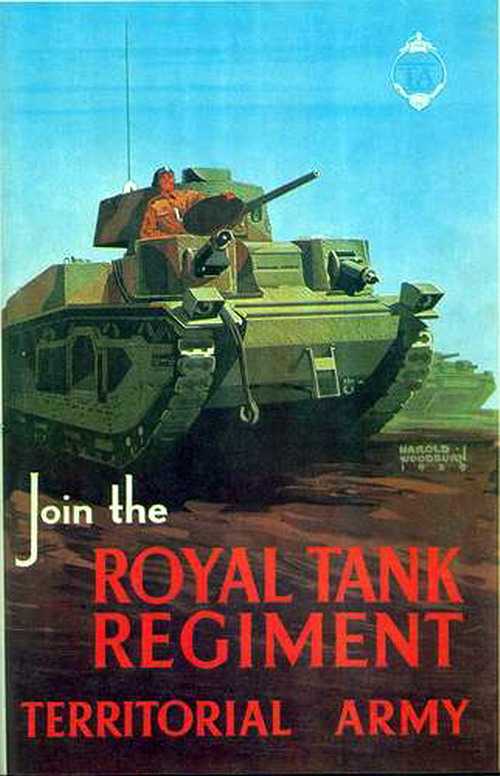
Posters Artwork Documents
Join the Tanks !
H.M. Government/IWM,
Poster exhorting the men of Britain to join the Royal Tank Regiment, Territorial Army. Technically, the RTR/TA was the formation succeeding the old Yeomanry - the earlier territorial home defence cavalry units usually formed, in long-gone times, by local gentlemen and well-to-do farmers who owned their own horses. The Yeomanry and Militia (infantry version) of Jane Austen's period had the reassurance of being able to swan around in their nice uniforms without any question of involuntary service outside Great Britain and Ireland (although English and Scottish Militia units in particular did play a vital part in the suppression of the United Irishmen rising in 1798). By 1939, however, the yeoman cavalry had been converted into a true reserve for the regular army "cavalry". By this time, all of these units had been mechanized to some extent. At about the time of the production of this poster, the Royal Tank Regiment consisted of three Regular Brigades, backed up by four Territorial brigades. While, at the outset, the intention appears to have been to confine less-well trained Territorial armoured units to scouting and secondary functions generally, as the war advanced, Territorial units were increasingly drawn into front-line functions, not only in terms of supplying replacements to Regular units, but in their own right. Territorial units, under their own designations, took a substantial part in Operation Overlord and, on the whole, performed well in the latter part of the war. One problem that had to be overcome in the design of this poster is that the official artist does not seem to have known what a suitable tank for inclusion in the poster might be. The poster suggests that he was shown the Vickers A1E1 Independent heavy tank/land cruiser, Britain's pioneering multi-turret tank, and told to paint away. There are inaccuracies in the portrayal; nonetheless, the A1E1 is the closest match to the tank in the poster. This was, in reality, a bit fanciful, even to the point of showing two A1E1s in the poster. Only one prototype of the A1E1 was ever produced. Noting the various limitations of the vehicle, the War Office had abandoned the A1E1 programme as far back as 1929. Still, it looked impressive and that, presumably, was the point. The A1E1's innovative technology was important for the development of later British tanks, and was quite influential in influencing the short-lived multi-turret tank programmes of other nations, notably the Soviet Union. However, the possibility of making the A1E1 a major British combat tank, by 1939, had long passed. Best regards, JR.
2292 Views
3/24/2014
